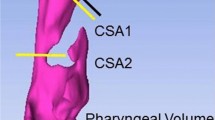Abstract
We retrospectively studied the incidence of difficult laryngoscopy in 53 subjects with obstructive sleep apnea syndrome (OSAS) undergoing uvulopalatopharyngoplasty (UPPP) and 72 subjects with chronic otitis media undergoing tympanoplasty (control group). The incidence of difficult laryngoscopy in the UPPP group was significantly higher than in the control group (18.9%vs 4.2%,P<0.001). To analyze the anatomical findings of difficult laryngoscopy in UPPP patients, cephalometric roentgenograms were compared between patients in whom direct laryngoscopy was difficult (difficult patients,n=10) and patients in whom direct laryngoscopy was not difficult (nondifficult patients,n=43). Cephalometric atlanto-occipital distance (cAOD) was less than 4mm in 80% of the difficult patients, and there were significant differences between the difficult patients and the nondifficult patients (2.8±3.3 mmvs 6.7±3.0 mm, mean ±SD,P<0.001). There were significant differences in cephalometric effective mandibular length/cephalometric posterior depth of mandible ratio (cEML/cPDM) between the difficult patients and the nondifficult patients (4.0±0.6vs 4.5 ±0.8,P<0.01); however, the calculation of cEML/cPDM was more difficult than cAOD. We concluded that OSAS patients undergoing UPPP are at high risk for difficult laryngoscopy, and that cAOD calculated from cephalometric roentgenograms is an easy and sensitive predictive indicator for the estimation of difficult laryngoscopy.
Similar content being viewed by others
References
Fujita S, Conway W, Zorick F, Roth T (1981) Surgical correction of anatomic abnormalities in obstructive sleep apnea syndrome: Uvulopalatopharyngoplasty. Otolarygol Head Neck Surg 89:923–934
Partinen M, Guilleminault C, Quera-Salva M-A, Jamieson A (1988) Obstructive sleep apnea and cephalometric roentgenograms —The role of anatomic upper airway abnormalities in the definition of abnormal breathing during sleep. Chest 93:1199–1205
Jamieson A, Guilleminault C, Partinen M, Quera-Salva MA (1986) Obstructive sleep apneic patients have craniomandibular abnormalities. Sleep 9:469–477
Hegstrom T, Emmons LL, Hoddes E, Kennedy T, Christopher K, Collins T, Spofford B (1988) Obstructive sleep apnea syndrome: Preoperative radiologic evaluation. Am J Roentgenol 150:67–69
Davies RJO, Stradling JR (1990) The relationship between neck circumference, radiographic pharyngeal anatomy, and the obstructive sleep apnea syndrome. Eur Respir J 3:509–514
Ryan CF, Dickson RI, Lowe AA, Blokmanis A, Flectham JA (1990) Upper airway measurements predict response to uvulopalatopharyngoplasty in obstructive sleep apnea. Laryngoscope 100:248–253
Okamoto M, Fujita S (1993) Role of dynamic cephalometry in upper airway evaluation of obstructive sleep apnea syndrome In: Togawa T, Katayama S, Hishikawa Y, Ohta Y, Horie T (ed) Sleep apnea and rhonchopathy. Karger, Basel, pp 100–106
Cormack RS, Lehane J (1984) Difficult tracheal intubation in obstetrics. Anaesthesia 39:1105–1111
Vgontzas AN, Tan TL, Bixler EO, Martin LF, Shubert D, Kales A (1994) Sleep apnea and sleep disruption in obese patients. Arch Intern Med 154:1705–1711
Mallampati SR, Gatt SP, Gugino LD, Desai SP, Waraksa B, Freiberger D, Liu PL (1985) A clinical sign to predict difficult tracheal intubation: a prospective study. Can Anaesth Soc J 32:429–434
Oates JDL, Macleod AD, Oates PD, Pearsall FJ, Howie JC, Murray GD (1991) Comparison of two methods for predicting difficult intubation. Br J Anaesth 66:305–309
Rocke DA, Murray WB, Rout CC, Gouws E (1992) Relative risk analysis of factors associated with difficult intubation in obstetric anesthesia. Anesthesiology 77:67–73
White A, Kander PL (1975) Anatomical factors in difficult direct laryngoscopy. Br J Anesth 47:468–474
Nichol HC, Zuck D (1983) Difficult laryngoscopy—the “anterior” larynx and the atlanto-occipital gap. Br J Anesth 55:141–144
Chou H-C, Wu T-L (1993) Mandibulohyoid distance in difficult laryngoscopy. Br J Anaesth 71:335–339
Author information
Authors and Affiliations
About this article
Cite this article
Kato, S., Hoshino, M. & Goto, F. Difficult laryngoscopy and cephalometric roentgenograms in obstructive sleep apnea syndrome patients undergoing uvulopalatopharyngoplasty. J Anesth 10, 260–263 (1996). https://doi.org/10.1007/BF02483392
Received:
Accepted:
Issue Date:
DOI: https://doi.org/10.1007/BF02483392




